
| KIT #: | 92012 |
| PRICE: | 2800 yen at www.hlj.com |
| DECALS: | Four options |
| REVIEWER: | Scott Van Aken |
| NOTES: | Injected plastic with vac canopy and etched brass details |

| HISTORY |
The Ki-27 was the army's main fighter until the start
of World War II. In the 1939 Battle of Halhin Gol against USSR in Mongolia,
Ki-27 faced I-15 biplanes and I-16 monoplanes, and dominated them with its
maneuverability, downing a total of 1,252 enemy aircraft. The Ki-27's high turn
performance caused the Army to focus almost exclusively on maneuverability, a
decision which came back to haunt them later as it handicapped the development
of more heavily armed and faster fighters. The Ki-27 served until the
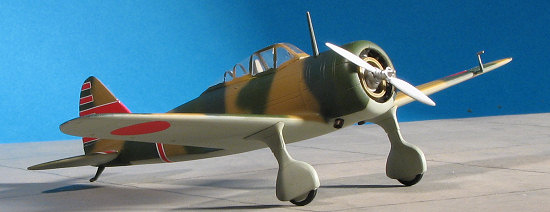 beginning
of World War II in the Pacific, escorting bombers attacking Singapore. After it
was replaced by the Ki-43, Ki-27 continuing to serve as a trainer, was used in
'back water' areas and for home defense. It was also exported for use with Manchukuo and Thai armed forces, seeing combat with both. In Thai service, the
Ki-27 reportedly damaged a P-51 Mustang and shot down one P-38 Lightning. Near
the end of World War II, a few Ki-27 were equipped with up to 500 kg (1,100 lb)
of explosives for Kamikaze duty.
beginning
of World War II in the Pacific, escorting bombers attacking Singapore. After it
was replaced by the Ki-43, Ki-27 continuing to serve as a trainer, was used in
'back water' areas and for home defense. It was also exported for use with Manchukuo and Thai armed forces, seeing combat with both. In Thai service, the
Ki-27 reportedly damaged a P-51 Mustang and shot down one P-38 Lightning. Near
the end of World War II, a few Ki-27 were equipped with up to 500 kg (1,100 lb)
of explosives for Kamikaze duty.
In spite of its excellent turning performance, in combat Ki-27 suffered from lack of armor protection for the pilot and absence of self-sealing or fire suppression in the fuel tanks. In addition, the airframe could not handle the stress of high speeds and Soviet pilots routinely escaped Ki-27 attacks in a dive. The armament of two rifle-caliber machine guns was weak. Many of these planes were shot down by the P-40s of the AVG. The main difference between the Ki-27a and Ki-27b was the latter's addition of bomb racks and the provision for under wing fuel tanks.
Thanks to http://en.wikipedia.org for most of the background info.
| THE KIT |
I have to say that this looks an awful lot like a modern Eduard kit. The same green-grey plastic, the same nicely done engraved detailing and the included etched set is even done by Eduard (though that is not surprising as many Czech produced kits include Eduard photo-etch).
You may wonder why a whole family of
Ki-27/Ki-79 aircraft are being done. Hasegawa's kit is still quite nice, but
the molds are at least 35 years old and I
can only guess that RS wanted to start off their injection molded kits
 with
something that had some legs. By that, I mean the you can take the same basic
sprue (the big one) and then add those bits that are necessary for the
different Ki-27 and Ki-79 variants. You see that there are two different
engines and two seats on the wing sprue along with 'bare' landing gear legs
and wheels. These are not all needed for the Ki-27.
with
something that had some legs. By that, I mean the you can take the same basic
sprue (the big one) and then add those bits that are necessary for the
different Ki-27 and Ki-79 variants. You see that there are two different
engines and two seats on the wing sprue along with 'bare' landing gear legs
and wheels. These are not all needed for the Ki-27.
In
fact, if you get right down to it, this kit does not have all that many parts
to it. Most of the construction will be in the details. The interior side
walls have nicely molded detailing and atop that will go a ton of photo etch.
There are the usual instrument panels, seat, control sticks, various dials and
little boxes along with rudder pedal bars and a rear framework piece. There
are even bomb racks in p.e. though the kit does not include any bombs
(probably for a different version). The kit does include dual 'bosom' fuel
tanks if you wish and also you'll have to make the twin pipes that extend from
under the left wing. I really don't know what those are, though they may be
fuel dump pipes. I also note that the spatted wheels are butt joined to the
upper section, which is in turn,  butt joined to an area under the wing. Unlike
some kits of this nature, there are no 'plastic or photo etch' options so you
have to do with what is given, even if you don't like the flat p.e. pitot
tubes and control columns. A single very nicely done vacuform canopy tops
things off. I do with they'd have included two.
butt joined to an area under the wing. Unlike
some kits of this nature, there are no 'plastic or photo etch' options so you
have to do with what is given, even if you don't like the flat p.e. pitot
tubes and control columns. A single very nicely done vacuform canopy tops
things off. I do with they'd have included two.
Two sheets are provided for instructions. One is for the actual building of the kit and the other for the markings options. The instructions are well printed and include color information. When parts have to be made (stretched sprue), the dimensions are shown. Color reference is generic and Humbrol/Agama. Markings are for four aircraft. One is the box art plane from the 246 Sentai in 1943 on home defense duties. The red cowling and white 'bandages' will have to be painted. Next, in dark green over light grey is a 9 Sentai plane from Manchuria in mid 1943. In a variegated pattern of grey, green and brown is a 24 Sentai aircraft in the Philippines during December 1941. The final aircraft is from the 77 Sentai in Thailand during 1942. It is in an overall light grey color. I don't think the Army had the same brownish grey of Navy A6Ms. The decals are superbly printed and while the reds seem a little intense, this may well be accurate for Army aircraft.
| CONSTRUCTION |
The first thing I did was to check over
the instructions and look for subassemblies. There aren't any aside from the
cockpit. Much of the cockpit is based on photo-etched parts. Many of these are
quite tiny and so even folding them is a challenge. However, if you have a
folding tool such as an Etchmate, then this won't be as difficult as it seems.
One thing I noticed right off is that there are no dedicated placement spots for
the photo-etch or anything else. The interior walls are a nice framework, but it
is up to the 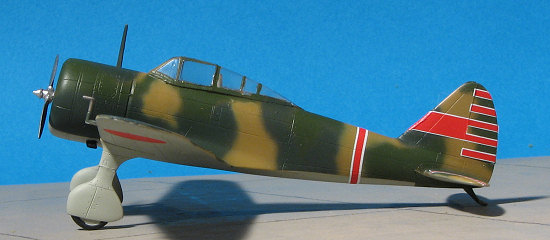 builder to make room
for the bits. Instructions are a bit vague on actual placement as well. It would
be nice to have an 'after' images with the bits in place. I decided to use as
much photo etch as I could so spent considerable time getting the rather flimsy
back bulkhead in place and then gluing the p.e. seat to it. Then there are
cushions and floor instruments as well as a p.e. control stick.
builder to make room
for the bits. Instructions are a bit vague on actual placement as well. It would
be nice to have an 'after' images with the bits in place. I decided to use as
much photo etch as I could so spent considerable time getting the rather flimsy
back bulkhead in place and then gluing the p.e. seat to it. Then there are
cushions and floor instruments as well as a p.e. control stick.
Instrument panels have acetate instruments where one paints the back of the acetate in white then attaches the acetate to the back of the panel. I used clear gloss paint for this. There are two guns that fit on the floor with ammo belts that attach. Rudder pedals are also p.e. and I had to make a pedestal for them out of stretched sprue. When I was done, the assembly and interior were painted a darkish grey as directed by the instructions. Meanwhile, I had painted the engine as it needs to be installed when the fuselage halves are glued together.
Then I had the first inkling that this wasn't going to be easy. I should preface all this by pointing out that I couldn't get the ammo belts to fit. Regardless of what I did, I could not get things to match the drawings. I also found that when I test fit the interior, I couldn't get a good fit. I had to cut away about the lower 1/4 or so of the molded in sidewall framework on both sides or the seat would be so far down in the cockpit that no pilot would be able to see above the opening. Fortunately, I have a very nice micro-chisel that works wonders in such conditions. There is no indication of just where the engine fits, either. One just glued the cylinder heads to the interior and hopes for the best. Since I use a 'hot' glue, this helps. After making sure the interior fit on both sides, I glued the interior to one half and let it dry. Then I glued the fuselage halves together. I was not surprised to notice that the etched metal rear framework was too wide and so it 'scrunched' when I glued the halves.
At this time, some would despair.
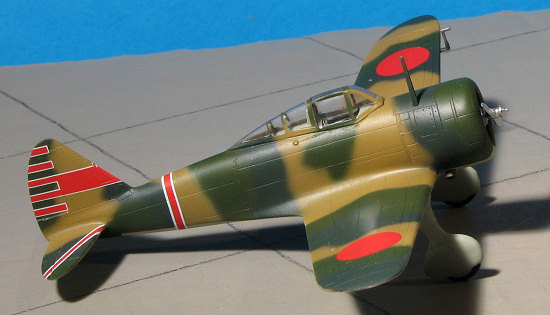 However, I was determined to finish
this one so soldiered on in the knowledge that little could be seen through the
tiny cockpit opening, even though it really meant that all that work had gone
for naught.
However, I was determined to finish
this one so soldiered on in the knowledge that little could be seen through the
tiny cockpit opening, even though it really meant that all that work had gone
for naught.
During this time, I assembled the wings. The rear wing section is really too thick and could do with some scraping down to get a thin trailing edge. I didn't do this. With the fuselage together and filler applied to the usual areas and sanded down, I glued on the tail planes. This is something I try to do before attaching the wings as it allows one to at least have a chance to get the wings properly aligned!
Then I glued on the wings. No surprise here that I needed filler everywhere. The kit offers parts for doing the wheels without spats, though all the options in the kit had them. This meant that instead of one piece wheel/strut, these bits were two piece. I first glued on the upper sections to correspond with the etched guides on the wing. Then I glued on the lower spatted sections. Fit is not that good and I somehow ended up with them at slightly different angles. Next time (as if I'll build another of these) I'll drill out both parts and insert a section of wire to help out. The tail skid was glued in place at this time.
Next the canopy. It has well defined frame lines and though only one is provided, I had little trouble cutting it out and getting it ready to install. I masked it with Tamiya tape and found that the upper portion of the canopy was so thin that I accidentally cut through it while cutting the tape. This is one of many reasons that I think that two vac canopies should be with every kit and the more enlightened manufacturers provide this option. I filled the cockpit with tape and masked off the engine.
| COLORS & MARKINGS |
There are four decal options provided,
each offering an interesting scheme. I chose the one for the Philippines in
December 1941 for my model. This consists of the standard grey on the underside
with the upper surface in two greens and a light brown. I looked through my
paints and found I still had some of the old Aeromaster acrylics for these
shades. The two greens are a bit close to
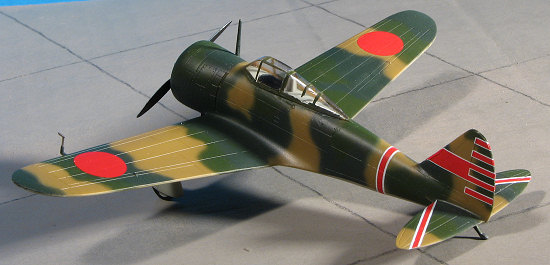 each other in shade, but I had
them and figured I might as well use them.
each other in shade, but I had
them and figured I might as well use them.
I first painted the entire airframe in Japanese Army Grey-Green as that is how these were delivered from the factory. I masked off the lower surfaces and then attached the canopy using white glue. When that was dry I returned to the paint shop.
I thinned the other three colors to near water consistency. The matte surface onto which I would be spraying will prevent any 'runs, drips and errors' due to the thin paint and I used low (about 7 psi) pressure to free hand the camo scheme using my Skybow AB-100 detail airbrush. The Light Earth was first and I did the entire upper surface with this shade. Next, I used Nakajima Army Green and Nakajima Navy Green for the two green shades. As I had feared, the acrylic paint dried on the tip rather easily, requiring much stopping and wiping of the tip to remove the dried paint. This made the painting process longer than I'd have liked, but all turned out well. When I was satisfied with the camo scheme, I gave the entire model a Future (gloss clear acrylic) overcoat
The decals are absolutely superlative. They are thin, opaque and responded well to ordinary Microsol/set. In fact, they are the best part of the kit and well worth keeping for other projects.
| CONSTRUCTION CONTINUES |
With the decals in place and dry, I
added the final bits, which included the cooler thingie for the front of the
engine. This part fits where it touches as again, there is no concrete
attachment point for it. The p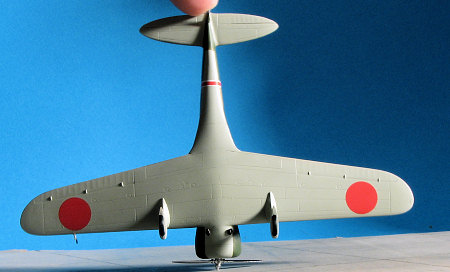 rop
was glued on as was the radio mast and the pitot tube. I also glued on the
exhaust. Even these tiny parts had seam lines to scrape! I gave the model a
coat of Future/matte base to dull things up. The masking was removed without
trauma and some touch-up painting was done. Final step was to glue on the
prop.
rop
was glued on as was the radio mast and the pitot tube. I also glued on the
exhaust. Even these tiny parts had seam lines to scrape! I gave the model a
coat of Future/matte base to dull things up. The masking was removed without
trauma and some touch-up painting was done. Final step was to glue on the
prop.
| CONCLUSIONS |
It isn't often than I don't recommend a kit, but I have to say that given the choice between this one and the old Mania kit that is boxed by Hasegawa, I'd have to go with the Hasegawa kit. As you can see by the fact that I finished it, it isn't unbuildable, but one certainly has to deal with poor fitting parts throughout the build process. The extra detail is a moot point as most is in the cockpit where it can't really be seen. If one insists on this kit, then use as few of the photo etch bits as possible. They do little to enhance the build, and again, they are almost all used for the interior. The shining light of the build is the excellent decal sheet and I fully plan on using this sheet when I do a Hasegawa kit.
My thanks to www.hlj.com for the review kit. Get yours direct. Save money, buy lots!!
March 2007
#1460 in a series
Copyright ModelingMadness.com. All rights reserved. No reproduction in part or in whole without express permission from the editor.
If you would like your product reviewed fairly and fairly quickly, please contact the editor or see other details in the Note to Contributors.